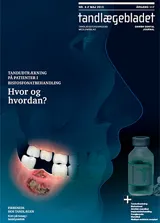Retningslinjer for tandekstraktion på patienter i bisfosfonatbehandling
Introduktion og formål – Bisfosfonater (BF) reducerer knoglenedbrydning, smerte og hyppigheden af spontane frakturer hos patienter med osteoporose eller cancer med knoglemetastaser. Én bivirkning til BF-behandling er osteonekrose i kæberne (ONJ). Ofte er ONJ hos denne patientgruppe udviklet efter tandekstraktion. Formålet med denne artikel er derfor at angive generelle retningslinjer for ekstraktion af tænder på patienter i BF-behandling. Metode – Retningslinjerne er baseret på en analyse af den tilgængelige litteratur. Der er foretaget søgning på PubMed med en række nøgleord og efterfølgende litteraturgennemgang. Gennemgang af foreliggende videnskabelig litteratur – Der er publiceret 10 studier omhandlende ONJ-forebyggende behandlingstiltag på patienter i BF-behandling med behov for tandekstraktioner. I de fleste studier har man under antibiotikadække foretaget opklapning, tandekstraktion efterfulgt af alveolektomi samt primær lukning. Ved tandekstraktionerne er ozonterapi, laserterapi og anvendelse af Plasma Rich Growth Factor også blevet beskrevet. Konklusion – På baggrund af litteraturgennemgangen kan det konkluderes, at patienter i højdosis BF-behandling med behov for tandekstraktion bør henvises til en kæbekirurgisk hospitalsafdeling for tandekstraktion med efterfølgende alveolektomi og primær lukning. Patienter i lavdosis BF-behandling med behov for tandekstraktion kan behandles i primærsektoren med almindelig tandekstraktion uden primær lukning. Ved tegn på blottet knogle fire uger postoperativt bør patienten henvises til en Kæbekirurgisk hospitalsafdeling.
Guidelines regarding tooth extractions on patients receiving bisphosphonate treatment
Introduction and purpose – The purpose of this article is to promote general guidelines for tooth extraction on patients receiving bisphosphonate (BF) treatment. Methods – The guidelines are based on an analysis of the available literature. A PubMed search has been conducted followed by a review of the literature. Review of the existing scientific literature – Ten studies were found on tooth extractions in patients receiving BF treatment. In these studies non-traumatic tooth extractions in general have been performed with the patients under antibiotic therapy. Furthermore, in most of the studies a local flap was raised, followed by alveolectomy and primary closure. In addition, ozone-therapy and laser-therapy have been described, while more recent studies have investigated the effect of applying Plasma Rich Growth Factor in the extraction socket. Conclusion – Patients receiving high dose BF treatment (notably cancer patients), tooth extraction should be followed by alveolectomy and primary suturing is. Such patients should be referred to an oral and maxillofacial hospital department for treatment. Patients receiving low dose BF-treatment (notably patients suffering from osteoporosis) in need of tooth extraction, can be treated by simple tooth extraction, without primary suturing in the primary health care sector. Patients with non-healing bone lesions beyond four weeks postoperatively should be referred to an oral and maxillofacial hospital department.


